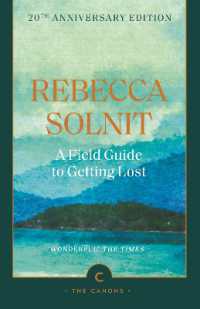- ホーム
- > 洋書
- > 英文書
- > Cinema / Film
Full Description
Explore the inspirations behind the work of the legendary Hayao Miyazaki, one of animated cinema's all-time great creators.
Often called the godfather of animation, Miyazaki is able to imagine and populate worlds like no other director or animator. His films, from My Neighbour Totoro to the Oscar-winning Spirited Away and The Boy and The Heron, are deeply original, each conjuring up their own complete and entrancing version of reality.
This book journeys through the rich mix of cultural, historical and artistic influences that shape Miyazaki's storytelling. From Japanese folklore and childhood memories to architecture, classic cinema, literature and political commentary, it reveals how Miyazaki's deeply personal vision creates layered worlds that somehow feel both fantastical and grounded in truth.
With insight into his process, visual language and recurring themes - including nature, flight, girlhood, resistance and renewal - The Worlds of Hayao Miyazaki offers fans and film lovers a deeper understanding of the imagination behind the magic.
A celebration of creative freedom, storytelling without limits, and the enduring power of animation.
Contents
Chapter One
Four Ways Through The Looking Glass
How Four Great Writers Have Inspired Miyazaki's Story-Building
Chapter Two
We Could Be Heroes
How Four More Writers Yielded Models Of Young Female Independence
Chapter Three
All The Worldʼs A Stage
The Actual Places That Inspire Miyazaki's Realistic Fantasies
Chapter Four
National Treasures
Homegrown Japanese Influences On Miyazaki, From The Spiritual To The Culinary
Chapter Five
Songs Of Innocence And Experience
The Personal Memories That Haunt (And Cheer Up) Miyazaki's Movies
Chapter Six
Visions Of The Future
How And Why Miyazaki Portrays The Possible Worlds To Come
Chapter Seven
Drawn From Life
Miyazaki's Sources And Models For Animating Movement
Chapter Eight
Drawn In
The Animated Films That Inspired Miyazaki
Chapter Nine
Live-Action Cinema
How Miyazaki Thinks Through Film History
Chapter Ten
The Big Picture
Four Ways Of Framing Miyazaki






